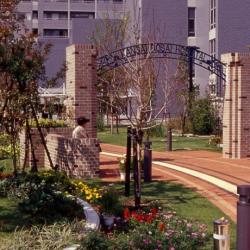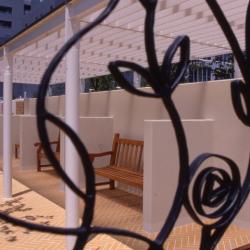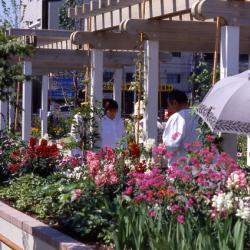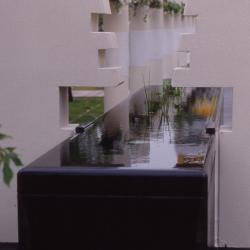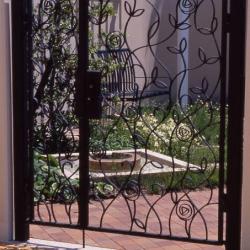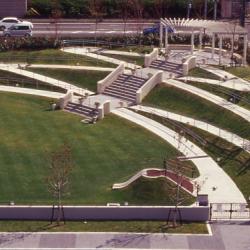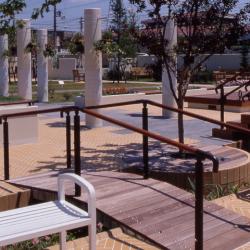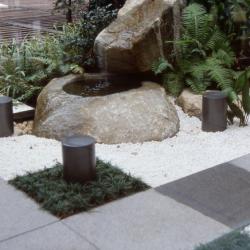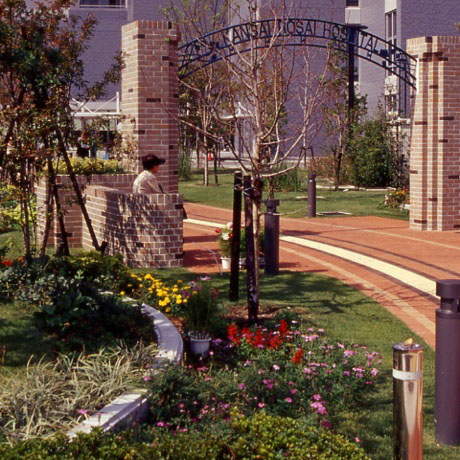
Introduction
Launched as part of renovation project in celebration of the 50th anniversary of the Kansai Rosai Hospital, the Healing Garden is the first of its kind in Japan. Located in an industrialized area in Amagasaki in the Hyogo prefecture in south central Japan, the acute care hospital grounds are bordered by apartments and a heavily traversed road. Given its location, designing a mixed-use, serene, healing garden posed many challenges. Through thoughtful design of sound barrier walls concealed with planting mounds, industrial noise is virtually eliminated in this 1.2 acre [5,000 square meter] garden. The tranquil and welcoming healing garden is divided into nine different areas tailored to the needs of its varied users. It is widely used and enjoyed by patients and their families, hospital staff, and those living in nearby communities. “Surrounded by buildings, housing, and a heavy traffic road, the garden has become an oasis for not only the hospital, but also for people living in nearby communities.”
Description
Designed by Yoshisuke Miyake of SEN, Inc. and installed in March 2004, the Kansai Rosai Hospital Healing Garden is located in Amagasaki, Hyogo prefecture in Japan. The 670-bed acute care hospital serves patients with industrial injuries. The hospital has 20 departments staffed by 95 doctors and 388 nurses. It is located in a dense, mixed-use area bordered by heavy traffic. The Garden is the first of its kind in Japan and has received a lot of attention and interest. It was created on the site of a former parking lot in front of the main hospital building. The Garden, called “Ibuski-no-sono” (Garden of Life), it is about 1.2 acres [5000m], with its west side facing the hospital building, the east facing the heavily traveled road and a bus stop with pedestrian crossing, to the south, apartment buildings and shops, and to the north, the hospital’s maintenance facilities. There are two entrances to the garden. One entrance faces the primary path to the hospital and the other is in the center of the east side of the garden. A one meter wall surrounds the garden, making the entire space visible from outside its walls. Because the city has a temperate climate, users enjoy the garden and its attractive features year-round. A team of hospital park volunteers meticulously maintains the garden.
The Garden was designed to meet the needs of hospital patients, their families, and staff, but also welcomes local community residents. Users may enjoy the garden by being in it or viewing it from inside through windows in the cafeterias, and offices. Ample lighting makes it enjoyable both day and night. The south side of the Garden is open to the sun. Tree canopy and covered shelters provide opportunities for shade. The north side of the garden is very colorful, providing contrast and a choice of vibrant space for users. To dampen the sound from the busy road, the east side of the garden is walled and heavily mounded. The west side of the garden borders the entrance path to the hospital.
Photos
Entrance
Photo Credit:
Seating Area
Photo Credit:
Garden of Four Seasons
Photo Credit:
Water Feature
Photo Credit:
Garden of Memories
Photo Credit:
Aerial Views
Photo Credit:
Design and the User Experience
The three goals in planning and designing the Garden were to:
- Create a verdant welcoming space
- Allow users to experience the healing power of nature
- Develop a system for good maintenance over time.
Wheeled mobility users were consulted as part of the design process, as were physical, occupational, and horticultural therapists. Drawing on principles of universal design as well as the overarching goals of the project, the garden design was intended
- To allow people to experience natural cycles
- Invite people to sense the passage of time through the growth of flowers and trees
- Stimulate the five senses
- Create a space for people to meditate
- Invite social interaction
The design included nine sections, each named to represent their specific intentions. The Hospital Entrance Path Area welcomes people to both the garden and hospital. It contains deciduous trees familiar in Japan, which are intended represent the life cycle.
The Garden of Four Seasons contains four raised beds containing aromatic and visually appealing flowers flanking a wide pathway. The beds are raised to allow wheeled mobility users to most easily touch and smell the flowers.
The Garden of Whispering Sounds contains semi-private covered sitting areas for quiet conversation or personal meditation, and a raised water feature designed for play, listening, and viewing.
Sunshine Square is an open grassy space that can be crossed via a wooden path. The Square contains “whispering benches” at the corners, a space for two people to speak quietly across a small table.
The Sunken Flowers section was designed with patient physical rehabilitation in mind. The bridges over the sunken flowerbeds have handrails on both sides, are built at a 4% slope; stairs that are the same dimensions as those in Amagasaki to provide realistic simulations in preparation for community re-entry. Moveable benches allow family members to sit and watch their loved ones engage in their therapies or just to enjoy the plantings.
The Garden of Memories is a refuge for grieving family members to seek respite. Access is with a key, and white, lightly scented flowers and a small water fountain create a tranquil space. Shimmer Lane contains four semi private sitting areas separated by hedges for patients to sit alone or visit quietly with others. Since most hospital rooms in Japan are designed for 4-6 patients, this get-away space is important. For safety purposes, the front of the sitting areas are open.
Because Shimmer Lane and Garden of Memories are located on the east side of the garden next the loud street, a 2.5 meter high and 4 meter thick concrete wall and 2 meter high mounded planting area was installed to reduce industrial noise. The end result is that virtually no traffic noise can be heard within these sections of the garden.
Sunnyside Commons is an open grassy space with a small stage and a slide for young children. It also contains a Zelkova, a tree with a large and lovely symmetrical shade canopy, and because it is deciduous, emblematic of the life cycle of nature. The surrounding path is 100 meters long and has a counting device for users to track their walking distances. One side of the path contains slopes that replicate curb cuts, another useful tool for patients receiving rehabilitation services at the hospital who need to prepare to return to their communities.
Cherry Hill section contains a multitude of much loved Japanese cherry trees. The space contains two sloped walks; one is 4% and the other 8% to reach the top. Signs indicate the gradient of the slopes.
Evaluation
Extensive behavioral observations and post occupancy evaluations and surveys suggested the most popular section of the garden is the Garden of Four Seasons. The raised beds filled with alluring flowers attract many visitors. The seating areas are also widely used, especially those that offer shade, such as under the Zelkova tree and semi-private seating spaces. Interviews with 142 users suggested that about one quarter of them were visiting for the first time, while about two-thirds visit two or three times a week or daily. Time spent in the garden ranges from five minutes to an hour.
56% of users reported coming to the garden to sit and relax, 43% to view the plantings, and 29% to walk. A majority of users reported positive feeling about the maintenance and the benches in the garden. Because it is not typical for Japanese people to discuss feelings, 42% of those interviewed did not respond to a question asking how they felt after being in the garden, but of those that did respond, 30% indicated they felt calmer and more relaxed. Feedback from garden users included the following. A patient said, “Wisteria vines grow everyday. So I try [to do] my rehabilitation as hard as these vines.” Another shared, “I come here every morning. It is my little pleasure in [the] hospital.” Family members said, “I want my mother to spend her last moment at this hospital,” and “Strolling around the hospital park in [his] wheelchair make[s] my father happy.” One hospital staff member stated, “Looking [at] the hospital park through windows change[s the] atmosphere among staff.”
Not only is the Garden a space for relaxing and meditation, but by working closely with the hospital’s physical rehabilitation staff, the garden is also a unique and purposeful place to conduct therapy sessions. The gently graded slopes, bridges with handrails, steps, curb cuts, and raised beds, create a unique and motivating place for therapy.
One fascinating finding from the interviews was that of all user groups, staff uses the garden least. Initially some perceived that the garden was not a space for them. This misperception has been addressed, yet tight schedules prohibit many staff from spending time in the garden. In lieu of actual visits to the garden, it is the design team’s hope that views from hospital windows to the garden serve as a restorative experience for the staff.
When asked about what needed to be improved in the garden, 78% of the respondents said either, “no need for improvement” or “nothing to change.” Despite these overwhelmingly favorable comments, a similar follow-up survey is intended at a later date. The survey results suggests that the garden is being used as it was intended, as a place to relax, enjoy nature, and interact with others.
One missed opportunity is that people have to cross the hospital access road to get to the Garden. Some patients are reluctant to walk the additional 30 meters to get to the garden entrance. As suggested by Mr. Miyake, the primary designer, locating an additional small garden closer to the hospital entrance might have been one way to begin the journey towards health.
Universal Design Features
- The presence of signs indicating walking distances, gradients of slope walks, and benches that are well suited for transfers from wheelchairs.
- The semi-private seating areas in the Garden of Whispering Soundsand Shimmering Lane offer privacy, yet are open in the front to permit a greater level of safety.
- Lighting throughout the garden.
- Raised flowerbeds and elevated water features invite users of all ages and abilities to actively participate in the garden experience.
- A picnic area is available for patients to enjoy with their families.
- The stage at the lawn area is accessible for all to have an opportunity to be a “star.”
- Users have choices in how to enjoy the garden; there are nine sections of the garden, and each has different features to appeal to the widest range of users possible.
- The garden is safe. To prevent accidental rolling down to the water features, anti rolling down edges were installed.
- Adequate spaces for wheeled mobility users to stop at the base of ramps were installed.
- To prevent wheeled mobility users or those pushing baby carriages from accidentally going off stair landings, planters of flowers were installed as barriers.
- Flush and smooth pathways.
- In case of unexpected rains, rain shelters are located throughout the garden to keep vulnerable patients dry.
- Bridges located over sunken flowerbeds have handrails on both sides, are built at a 4% slope, and stairs that are the same height as those in Amagasaki-city provide realistic simulations for patients in preparation for community re-entry.
- One side of the Garden path contains slopes that replicate curb cuts, another useful tool for patients receiving rehabilitation services at the hospital.
- The raised flowerbeds are constructed at three different heights to accommodate sitting and standing users.
- Private spaces in the Garden of Memories acknowledge a user’s need to spend time alone in a contemplative environment.
Environmentally Sustainable Features
- Rainwater permeable floor finishes were used in the garden design.
- Familiar and native plantings, such as the Zelkova tree were installed in the Garden.
Project Details
PROJECT FACTS:
New Construction
Date Completed: March, 2004
Funding Sources: Private
Total project cost: 210,000,000 yen
Project Team
Client
Japan Labor, Health and Welfare Organization, Kansai Rosai Hospital
Project Manager
Takaharu Matsumura
Company: Tohata Architects & Engineers, Inc.
Email:
Telephone: +81-6-6202-0391
Universal/Inclusive Design Consultant
Name: Fusayo Asano
Company: Tokyo University of Agriculture
Architect
Name: Kazuhiko Miyagawa
Company: Tohata Architects & Engineers, Inc.
Telephone: +81-6-6202-0391
Landscape Designer
Name: Yoshiske Miyake
Company: SEN, Inc.
Email: post@sen-inc.co.jp
Telephone: +81-6-6373-4117
Contractor
Company: Joint-venture Group of Takenaka, Dainippon, Tomoe, & Hanshin
Engineer
Name: Chikara Tsuda
Company: SEN, Inc.
Email: post@sen-inc.co.jp
Telephone: +81-6-6373-4117
Horticultural Therapy Consultant
Name: Fusayo Asano
Company: Tokyo University of Agriculture
Additional information
2006 Award of Excellence in Design, Japan Institute of Landscape Architecture
ARTICLES
“Uses and Healing Effecs of the Garden of Kansai Rosai Hospital”
http://www.jstage.jst.go.jp/article/jilaonline/1/0/20/_pdf
Reference
Asano, F., Marcus, C.C., Miyake, Y., & Sasaki, M. (2008). Uses and healing effects of the Garden of Kansai Rosai Hospital. Landscape Research Japan Online, 1, 90-97.
Funding By


Propose a Case Study
Help us improve our Case Study library

